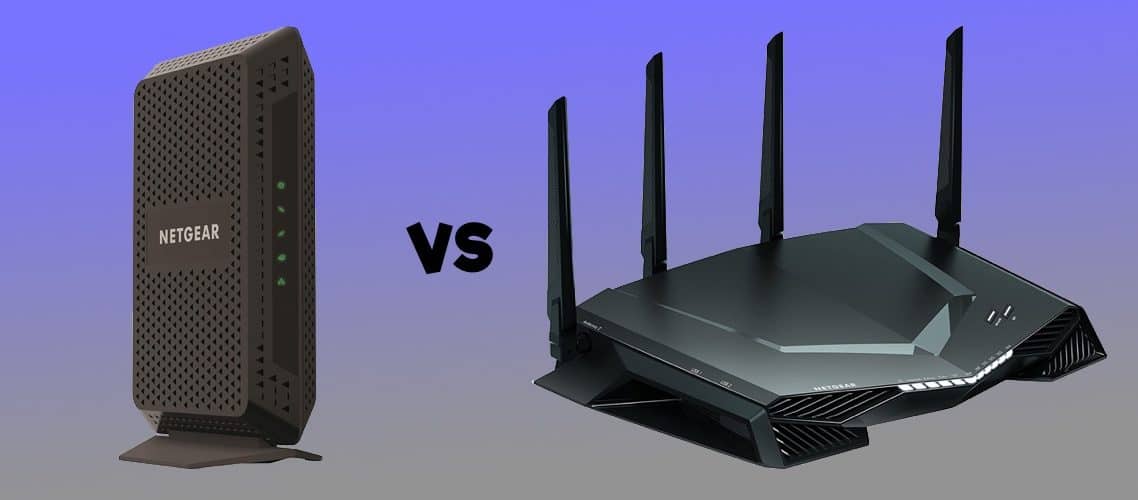
The router is a stand-alone device that connects to an Ethernet port on the modem and “routes” networking/internet traffic to its connected devices. If you want the most out of your broadband connection, using these ports for your hardware is the best option, especially if the ports support speeds of up to 1 gigabit per second (aka gigabit Ethernet). These can include desktops, laptops, HDTVs, gaming consoles, printers, and more. Routers can be designed for either cable or DSL connections, but both types have several additional Ethernet ports that are used for wired devices with a matching port or adapter.
#MODEM VS ROUTER IMAGES TV#
DSL is typically slower than cable-based broadband and useful in rural areas where phone lines already exist, but there’s no infrastructure supporting cable-based TV and internet services. This internet on-ramp is accessed through telephone lines instead of coaxial cables, so the connecting jack looks no different than what you would see on physical, land-based phones. Broadband can also be served up through a Digital Subscriber Line, or DSL. Newer modems on devices like laptops are also going more wireless, such as Intel’s 5G modems, but this isn’t yet a common option for the average in-home internet connection.īefore we move on, note that modems aren’t just for a coaxial cable connection. Another LED is provided, indicating that wired devices are accessing the internet. This is where you start in a troubleshooting scenario: If the send and/or receive lights are blinking, then your internet service provider is likely having issues, or something is going on with the connection outside. One light indicates that the unit is receiving power, one signals that it’s receiving data from your internet service provider, and one shows that the modem is successfully sending data.

Modems usually include lights/LEDs along their front, so you can see what’s going on at a glance.
Either way, you’ll need one to access the internet. But you can purchase compatible modems separately from any retailer to cut down on the monthly cost. These and similar broadband providers “rent” modems as part of their subscription plans so you can access their subscription-based service. They are offered as part of packages by IPSs (Internet Service Providers) across the United States, big players like Verizon, Comcast, and Spectrum. The modem is your on-ramp to the world wide web. Think of it as the interpreter that makes everything possible, translating the internet from the massive infrastructure highways to the smaller pathways inside homes and offices. It’s the door to the internet that receives and sends data between cables/telephone lines and all the devices in your home. Modem is short for “modulator demodulator,” which means that it modulates transmissions to receive and carry data. We’ll discuss both components in-depth and explain how they work together. While you can have a separate router and modem, you can also find devices that combine both functions - hence the confusion over which you have. If you've ever received a copyright-related correspondence from your ISP, that's because of your ISP's knowledge of your computer's IP address: The ISP, using the modem, assigns an IP address to your device when you connect to the network. Your modem would be a hunk of useless hardware without the ISP to communicate with it. Your ISP, or internet service provider, is the company you're likely paying to get internet service. There are also two important acronyms to know related to your modem: the ISP and IP address.

The modem will still be limited in its speed, and depending on the type of modem, may not even work at all. For instance, if you don't have access to fiber internet or 5G, it won't matter that your modem is top-notch.

But that's something your ISP is on the hook to fix, not you.Īnother issue that can impact modem connectivity is provider availability. For instance, old or damaged cable lines that connect your modem to the ISP can cause slower speeds. The main thing you'll be concerned with as far as your modem though is its reliability and speed connecting to the internet.Įven if you have the newest, fastest type of modem, factors beyond your control can impact its connection. They can be as small as a smartphone or as large as a box of cereal. Generally, a modem is black, with an appearance similar to a gaming console - flashing lights and a sleek, compact design. The modem authenticates and connects you to your chosen internet service provider (ISP), which might be a local provider or a national company like AT&T or Comcast. A modem is your gateway to internet access The essential difference between a modem and a router is that a modem connects you to the internet as a whole while the router manages and routes the internet to your devices.


 0 kommentar(er)
0 kommentar(er)
